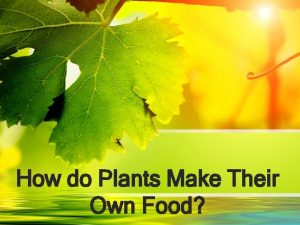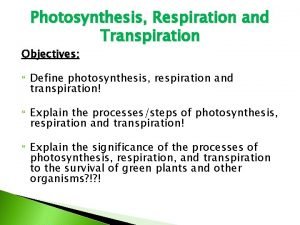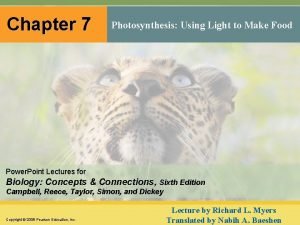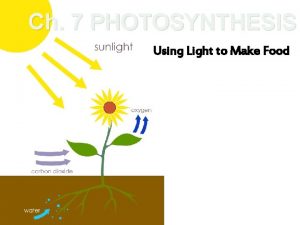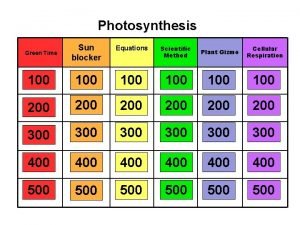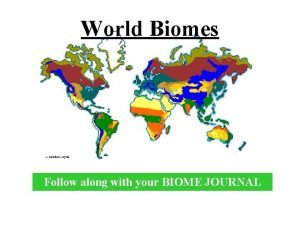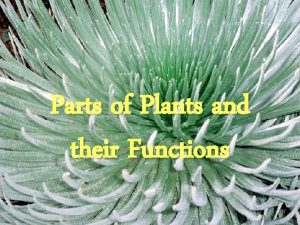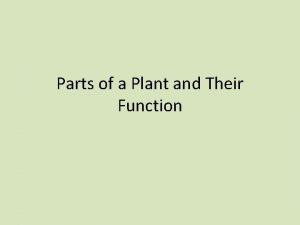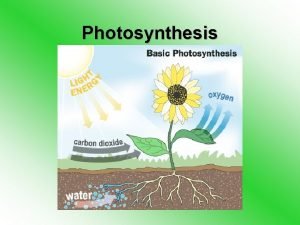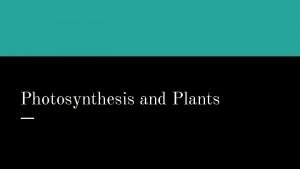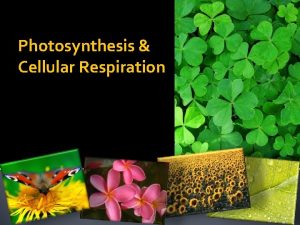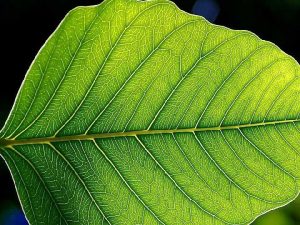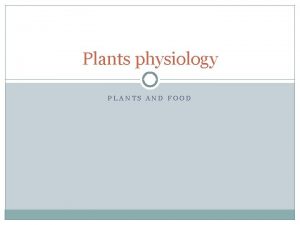Plants and Photosynthesis How do plants make their

















- Slides: 17

Plants and Photosynthesis

How do plants make their own food? Plants are autotrophic – This means they make their own food. The way plants make their own food is through a process called Photosynthesis

One of the raw materials that plants need to make food does come from the soil, the other comes from the air. What are these two raw materials called? carbon dioxide (from the air) water (from the soil) Plants use carbon dioxide and water to make their own food in a chemical reaction. What is the name of this reaction? Photosynthesis

Plants need energy for photosynthesis to take place. Where does this energy come from? light energy carbon dioxide (from the air) water (from the soil) The energy for photosynthesis comes from the Sun. Where in a plant does photosynthesis take place?

Photosynthesis takes place in the chloroplast found in plant cells. Notice that plant cells have many chloroplast in them.

What are the products of photosynthesis? light energy (radiant ) carbon dioxide (from the air) Glucose (chemical energy) oxygen water (from the soil) What type of energy transformation occurs during photosynthesis? Radiant / light energy to chemical energy

Energy Transformation • Photosynthesis transforms radiant/light energy from the sun into chemical energy in the form of glucose(sugar). e-education. psu. edu

Plant cells in the upper surface of leaves have chloroplasts which contain the green pigment called chlorophyll. light energy carbon dioxide (from the air) chlorophyll glucose oxygen water (from the soil) It is chlorophyll that absorbs light/radiant energy from the Sun to make photosynthesis happen.

Plants make their own food by the process of photosynthesis. In this chemical reaction, chlorophyll in plant cells absorbs light energy to change carbon dioxide and water into glucose and the by-product oxygen. What is the word equation for photosynthesis? light energy carbon dioxide water glucose oxygen chlorophyll This equation can be read as: “carbon dioxide and water, in the presence of light energy and chlorophyll, produces glucose and oxygen”.


Leaves are small ‘factories’ that produce food for plants by photosynthesis. Leaves are adapted so that photosynthesis can take place. Plants need carbon dioxide, water, sunlight and chlorophyll to carry out this important process. What features of leaves make them suitable for photosynthesis?

The features of leaf that make it suitable for photosynthesis are: l A leaf is broad and flat to capture lots of sunlight. l Veins carry water to the leaf and take food from the leaf to the rest of the plant. Veins also help to support the leaf. l Certain plant cells contain chloroplasts with chlorophyll. l Small holes called stomata in the underside of a leaf allow gases in and out.


How does water enter a plant? Water is one of the raw materials needed for plants to carry out photosynthesis. How does water enter a plant? Water from the soil enters a plant through the roots. You can’t normally see them but roots are a very important part of a plant. Why are roots branched and spread out through the soil?

How are roots adapted? Roots are branched and spread out for two reasons: l to absorb water (and mineral salts) from a large amount of soil. l to anchor the plant in the soil. Taking a closer look, roots are covered in root hair cells. Root hair cells have thin walls and a large surface area to help them absorb lots of water. How are roots adapted to their job? water

Why do plants need water? Water is needed by plants for photosynthesis but this important liquid is also used in many other ways: l to provide dissolved minerals that keep the plants healthy; l to transport substances around the plant; l to keep the plant rigid and upright; l to keep the plant cool; l to allow other chemical reactions to occur in plant cells. What happens to a plant if it does not get enough water?

Glossary l chlorophyll – The green pigment inside chloroplasts that plants need for photosynthesis to take place. l chloroplast – The part of a plant cell where photosynthesis occurs. l glucose – The sugar plants make during photosynthesis. l palisade cell – A type leaf cell with lots of chloroplasts. l photosynthesis – The process by which plants use carbon dioxide and water to produce glucose and oxygen in the presence of light and chlorophyll. l starch – Extra glucose from photosynthesis is stored as this substance which can be tested for with iodine. l stomata – Small holes in the lower surface of a leaf that allow gases in and out. l xylem – Tubes in veins that carry water around a plant.
 Where does photosynthesis happen
Where does photosynthesis happen Green plants make their own food by photosynthesis
Green plants make their own food by photosynthesis Chloroplast function
Chloroplast function Objectives of photosynthesis
Objectives of photosynthesis The process of photosynthesis
The process of photosynthesis Is photosynthesis a redox reaction
Is photosynthesis a redox reaction The food that plants produce during photosynthesis is
The food that plants produce during photosynthesis is Classify flowering and nonflowering plants
Classify flowering and nonflowering plants Temperate deciduous forest plants adaptations
Temperate deciduous forest plants adaptations Functions of parts of plants
Functions of parts of plants Six main parts of a plant
Six main parts of a plant Four basic parts of a plant
Four basic parts of a plant Make the lie big keep it simple
Make the lie big keep it simple Go make a difference in the world
Go make a difference in the world Make the lie big make it simple
Make the lie big make it simple Steps in photosynthesis
Steps in photosynthesis Nitrogen fertilizer for plants
Nitrogen fertilizer for plants Nonvascular plants
Nonvascular plants


